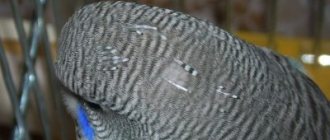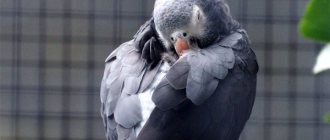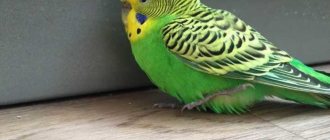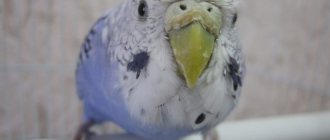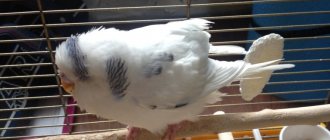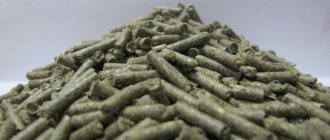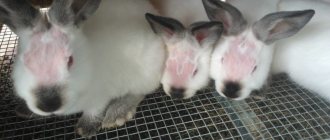Online magazine about parrots
Colors and patterns of budgies
We have translated and compiled for you a guide to the colors and patterns of budgerigars
Look
Popular article
Let's figure out how to choose a mate for a male or female budgie
2
Home › Diseases
In nature, wavy birds cover significant distances every day, so they can fly well and quickly.
The owner’s task is to create optimal conditions, thanks to which the bird will be able to leave the cage for a while for a full flight without fear or apprehension. But sometimes it happens that domestic birds very often spend their entire lives inside a cage, completely unable to fly.
In this article we will examine an important question - why budgies don’t fly and what to do about it.
- What could be the causes of obesity?
- Eating disorder
- Muscle atrophy
- Injuries
- Difficulty of adaptation
- Stress and depression
- Serious illnesses
- Pathologies
What could be the reasons
There are many reasons why parrots refuse to fly, for example, they may have serious illnesses or they are afraid of other pets. Lack of flight negatively affects the mood, health and weight of the wavy.
Therefore, the owner must ensure that the bird is not afraid to leave the cage . If necessary, treatment of diseases is carried out.
If a bird that previously flew well and for a long time suddenly refuses to fly, this usually signals the emergence of health problems.
Obesity
The bird’s diet completely depends on the person, so it is advisable to feed it not only with standard store-bought feed, but also with fruits and vegetables.
The daily portion should be balanced, and it is also advisable to feed the bird at the same time.
If you organize your pet’s diet incorrectly, he will quickly gain excess weight . Parrots enjoy eating nuts or sunflower seeds, but they contain a lot of fat, so they should be given in limited quantities.
It is advisable to increase the amount of vegetables and fruits that are beneficial in vitamins and contain a small amount of calories.
The main symptoms of obesity include:
- the appearance of shortness of breath after playing or moving around the cage;
- apathy and drowsiness;
- refusal to play and fly.
It is advisable to fill the feeder 2 times a day with 2 tsp. grain mixture, which is combined with vegetables, mineral supplements, fruits and berries.
Is your parrot tame?
Not really
Eating disorder
Eating problems do not always lead to obesity, as they can cause diseases. The bird must always have access to some kind of food, since the absence of food for even 6 hours can lead to death. This is due to accelerated metabolism, which is disrupted by poor nutrition.
Malfunctions in the body's functioning cause the pet to prefer to move as little as possible. He refuses to fly and play, and the condition of his plumage deteriorates. Since the body lacks vitamins, this leads to weakness, so the bird cannot rise into the air.
To avoid such unpleasant consequences, it is important to properly organize your diet. You cannot give your bird exclusively grain mixtures, so the bird should get a lot of vitamins from vegetables and fruits. It is advisable to germinate grains yourself and cook crumbly porridge in water. There should always be clean and fresh water in the drinking bowl, and chalk and sand should be placed at the bottom of the cage.
If you correctly adjust the bird’s diet, then literally after 2 months the parrot will be happy to return to regular flights.
Muscle atrophy
It is represented by a popular reason why the wavy cannot take off or gets tired quickly after a short flight. Atrophy appears in birds with limited physical activity.
If a bird is constantly in a cage without being able to get out, its muscles will atrophy. The same thing happens if the parrot lives in a cage that is too small and therefore cannot engage in any physical exercise.
To prevent atrophy, it is necessary to let the bird out of the cage every day to fly and play. The wavy should be able to move freely on different surfaces in the room.
Injuries
Wavys are represented by active and curious birds, which are very easy to scare. While exploring a room or flying, they often injure their paws or wings .
It is possible that a bird flies and falls. This usually happens if they are afraid of other pets or strangers.
If you choose the wrong cage, a bird's wing may get stuck in the space between its bars.
If the wavy is given freedom of movement around the room, it can catch its claw on a curtain or hit a window glass.
If the injury was caused by the owner, then you need to immediately pick up the bird to examine its legs and wings. If there is no symmetry of the wings, then this indicates a fracture or dislocation, so you need to urgently contact a veterinarian. The bones fuse within two weeks, and during this period flights are prohibited. If the bones do not heal properly, the bird stops flying.
Difficulty of adaptation
After purchasing a parrot, an adaptation period begins, during which the bird tries to get used to the owner and surrounding objects. In the first days, it is necessary to create a quiet and calm environment. It is recommended not to allow strangers or pets into the room. Do not play music at high volume or shout.
If the bird does not feel comfortable at home, it will refuse to leave the cage. It is advisable to use useful tips for training a wavy. If he gets used to a person, he will want to get out of the cage and fly.
Stress and depression
Budgerigars are sensitive to various changes in their lives, which can cause stress and depression.
This usually applies to the following situations:
- moving to a new place;
- the appearance of a new owner;
- attack by another pet;
- change of cage.
Therefore, if any changes are planned, it is recommended to apply them gradually. Stress is accompanied not only by a refusal to fly, but also by deterioration of plumage, decreased appetite and apathy. First you need to determine the cause of depression in order to quickly eliminate it. As soon as the wavy calms down and feels safe, he will return to his usual way of life.
Parrots are sensitive to the attitude of their owner, so if a person stops paying attention to the pet, the bird may get sick, lose its attractive plumage and stop flying.
Serious illnesses
The wavy will not move around the room and will not fly well if it suffers from any disease or parasites. Failure to fly is usually a consequence of French molt , which occurs in young parrots. It is accompanied by loss of feathers, brittle flight feathers and the appearance of blood on the skin. Under such conditions, the bird may become completely bald if immediate treatment is not started.
Wavys affected by French molt stop flying, so they can only run, since the disease cannot be completely cured.
If a bird is affected by parasites, it changes its habits, so it spends most of its time inside the cage, refuses to eat, and sits ruffled. Insects can be identified after a thorough examination of the bird , so if there are bite marks or small holes on the legs or beak, then the bird must be urgently treated for parasites. Their impact weakens the bird’s body, so it cannot fly.
It is advisable to carry out treatment based on the recommendations of a veterinarian. For this purpose, special ointments are applied to the affected areas of the skin. If a fungal disease is detected, it is accompanied by loss of voice, loose stools and refusal to eat.
After treatment and recovery, the bird returns to its usual behavior, so it enjoys flying or playing with humans.
Pathologies
Birds can exhibit different types of pathologies, but the most common is enlargement of the thyroid gland. The difficulty lies in the difficulty of making a diagnosis, and treatment rarely solves this problem. This pathology is accompanied by rapid fatigue, loss of appetite and heavy breathing.
If a problem is detected at an early stage, then the bird can be quickly treated, but usually people turn to veterinarians too late, so the parrot, even after expensive treatment, does not return to flying.
Effect of feed on bird activity
It's no secret that birds that receive all the vitamins and minerals necessary for their body along with food lead an active lifestyle. If this is not so, then the picture is completely opposite.
A poorly nourished pet will likely be lethargic and inactive. In this case, he spends the whole day half asleep. Moreover, if this situation has been going on for a long time, the parrot will weaken and may even die.
In cases where you notice a change in its condition in time and balance the food, within two months the bird will return to its usual rhythm of life and begin to fly more often.
However, on the other hand, excessive care can result in your ward becoming obese and again becoming inactive. In such cases, you are unlikely to be able to get the parrot to fly.
When the wavy birds begin to fly
All birds are designed to fly, so they begin to fly quite early. For them, this is a vital necessity, even when living at home.
Parrots that have the opportunity to fly regularly are distinguished by excellent health, not only physical, but also mental.
The first flights are made by one-month-old chicks . But after buying a bird, you need to wait a little for it to adapt to its new home, so for the first few days it should only be inside the cage.
A parrot that has not visually examined the territory beforehand may hit a mirror or other objects during flight, and may also begin to panic.
The first flights in a new place are allowed 2 weeks after purchase, since during this period the pet will get used to the room, so it can easily fly without touching various furniture. It is advisable that during this time the bird gets used to the hands, so it reacts calmly to the person.
Before the flight, you need to close the windows and remove dangerous objects, and also remove cats or dogs from the room.
Treatment
Every owner should be able to provide first aid to a feathered pet. If you have a cold, it is enough to warm the parrot (turn on an infrared lamp near the cage) and drink it with chamomile infusion.
Poisoning is of particular concern: small parrots have a very fast metabolism. Toxins that enter the body instantly penetrate all systems. A ruffled parrot with its eyes closed involuntarily shows that it needs urgent treatment. Sometimes the hours count.
Is it necessary for the wavy to fly?
It is vital for parrots to fly, as it has a positive effect on their health and mood. It is advisable to allow such walks only in the presence of a person. Before releasing the bird from the cage, it is recommended to make sure that there are no dangerous objects.
If the bird does not fly regularly, this leads to negative consequences:
- obesity;
- amyotrophy;
- weakening of bones and joints;
- the appearance of depression.
But sometimes there are situations when, even with the cage open, the bird refuses to come out or fly. You just need to wait until the wavy stops being afraid and gets used to the situation. If the bird suddenly stops flying, this may be due to stress, disease or parasites.
A bird that flies around the room every day always feels good and does not become overweight. Flying is a great way to get rid of apathy or melancholy. If you do not give the bird the opportunity to get out of the cage, it will become depressed.
Even if a bird refuses to fly for various reasons, it is advisable to let it out of the cage so that it can explore the surrounding area on foot. Some wavy cats happily ride on their owner's shoulder.
Correcting the situation
In order to return the bird’s love of flying in the apartment again, you should first of all turn to ornithologists for help. It is difficult for a parrot owner who does not have the appropriate education to identify the reasons for the pet’s passive behavior on his own.
A veterinarian will handle this task. After examination and diagnostic procedures, he will first find out the basis and possible pathologies. Then, depending on the individual characteristics of the bird, he will prescribe a therapy program.
If there is no reason for concern, the ornithologist will advise how to correct the situation with the reluctance to fly.
The health, physical and emotional state of the parrot must be carefully monitored. A symptom such as refusal or inability to fly is evidence of illness or physical injury to the bird. Therefore, this sign cannot be neglected. A timely visit to the veterinarian will save or improve the life of your feathered friend.
How to help a bird if it doesn't want to leave its cage
After purchasing a chick, it is recommended to wait until it adapts to the new environment and also gets used to the person. It is advisable to accustom the bird to being handled so that there are no problems with its return to the cage.
To do this, you need to feed the wavy by hand, and also carefully clean the cage. You cannot respond to aggression so that your pet is convinced of the low effectiveness of bites.
As soon as the bird gets used to your hands, you can periodically pull it out of the cage using your finger.
All windows and vents are first closed, and dangerous objects are removed. Usually such actions lead to the bird taking its first flight. it yourself onto furniture so that the parrot becomes interested in any object.
To return your parrot to its cage, you can lure it with treats.
Description
Refusal to fly is accompanied by other alarming details - changes in behavior, appearance, obvious symptoms of the disease. Based on the characteristic signs, you can accurately determine why the bird, which previously willingly fluttered out of the cage, has stopped responding to the door being opened, or is making attempts to take off, but to no avail.
Description of the problem
For example, if a parrot has gained excess weight, it is drowsy and has difficulty moving. When the cause is physical injury, the bird may cry out when moving. The disease is determined by elevated temperature, external changes, changes in litter, etc. But the best person to find out why a parrot doesn’t fly is a veterinarian ornithologist. You need to go to him, without relying on chance and information from the Internet.
Amyotrophy
Often the reason that a parrot does not fly can be muscle atrophy. It occurs when the bird is rarely allowed to fly and spends almost all its time in its cage. Limiting physical activity causes muscles to forget their functions. The parrot does not fly, but walks.
To avoid atrophy, you should purchase a cage that is 7 to 8 times the size of the parrot. If the bird is a large breed, it needs an aviary. The best prevention is to regularly (6-7 times a week) give the bird the opportunity to fly around the room. Regular flights will strengthen the bird's muscles and bones.
When buying a cage for parrots, you need to take into account that they move horizontally in their home. Therefore, in order to move freely, they need a long cage, not a high one.
How often should a parrot be released from its cage?
If a bird has a large, spacious house, then it does not need to be out in the wild often. But, if his home is small, then over time the pet will begin to experience discomfort and the flight will become simply necessary for him.
Be that as it may, each owner decides for himself how often he will walk his pet.
You can release a parrot at least every day. The main thing is to provide him with a safe flying environment.
So that the bird does not get used to freedom, it needs to fly no more than two to three hours, otherwise hysterics will begin, it can jump on the bars, scream loudly, demanding to be released.
In any case, the frequency of your pet's flights will depend on its activity, character and your free time. It is worth keeping in mind that young parrots require freedom regularly!
Take a closer look at your bird more often, and you will definitely understand when the time comes to take its first flight.
Need for flights
Budgerigars often become residents of city apartments. Their home is a cage on a table, on a windowsill. It seems big, but the bird is not as comfortable in it as in the wide space of a room or an entire apartment, where it can fly freely.
Flight is a vital need associated with the physical well-being of a bird.
Even a parrot that is naturally a poor flyer, or one that cannot fly at all, will try to flutter from the cage to the owner’s shoulder, from the chair to the back of the sofa. The owner should remember that in this way his pet strengthens its bones and resists:
The veterinarian will point out the importance of free-flying pet birds. He will advise giving freedom to wavy pets daily, or up to five times a week.
Fracture
The following signs are characteristic of a fracture:
- the parrot cannot stand on its leg;
- the bone is mobile in the place where the joint is missing;
- swelling, swelling of the surrounding tissue;
- redness or bluishness of the skin;
- passivity of the bird;
- paw drooping;
- the bird hides its paw under itself, which has not been observed before.
In some cases, it can be difficult to determine a fracture at home. The help of an ornithologist and special equipment are required: only a veterinarian can detect a fracture by palpation, and an x-ray is needed to confirm the diagnosis.
Preventing stress and illness
Protecting a parrot from emotional turmoil and illness is not so difficult. It is necessary to equip the living space with all the amenities so that the pet feels comfortable and does not get sick. The interior of the cage should contain only high-quality items, and the space itself should not be cluttered. In cramped conditions with an abundance of equipment, it is easy to get injured, after which the bird will need treatment.
When keeping at home, proper nutrition is important. Buy proven mixtures for your parrot, do not forget about the vitamin complex. Avoid overeating and obesity. If you have any unclear symptoms, consult your doctor.
A parrot does not always tremble from fear or cold. Chills appear for various reasons: from simple vitamin deficiency to dangerous psittacosis. It is important not to miss symptoms, start treatment on time and conduct annual preventive examinations with a veterinarian.
Bruises and sprains
If the bird tucks its limb under itself and tries not to lean on it, it is noticeable that the parrot has injured its leg by the swelling and redness that appears, the pain syndrome must be relieved. For this, special gels are applied; it is better to make a compress.
If the limb has acquired a bluish tint, the parrot's paw hurts, and the joint is in the wrong position, the bird has a dislocation. An ornithologist should treat such an injury. It is almost impossible for an amateur to correct a dislocated bird at home.

